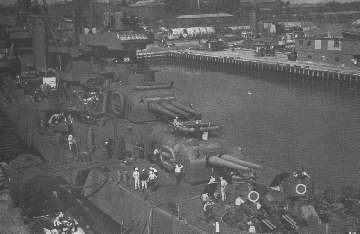



Immunity Zone Slide Rules
203mm
L/55 260lbs shell
203mm
L/55 335lbs shell
The standard gun for U.S. heavy cruisers, first employed in the Lexington-class carriers, then used in Salt Lake City, Portland, Northampton, New Orleans, Wichita and Baltimore classes; the later Des Moines, which didn't see service until after the war, used the same gun but employed automatic loading increasing the rate of fire (Mk 16 variant of the standard 203mm L/55).
The guns were mounted in hardly armored enclosed mounts until the Northamptons, then in armored turrets in the New Orleans class and following ships. It was found to be succesful, but had problems in so far as the slow rate of fire did not allow it to defend itself succesfully against enemy destroyers -- particularly at night.
Thus, although it had been the weapon of choice for U.S. commanders in surface action groups in 1942, by 1943 it had been replaced as such by the 6" L/47, and the ships carrying the 203mm gun were moved to carrier task forces or amphibious support groups.
The reason for the slower muzzle velocity and shorter range of Baltimore's Mk14 artillery was her firing of the larger 335lbs shell, a super-heavy variant of the original projectile. As with the 406mm L/45 super-heavy shells, the 335lbs shell outweighed contemporary similar-sized shells in other navies. Besides Baltimore and Des Moines, where the entire classes received this lighter gun, it was also fitted to Tuscaloosa, San Francisco, Quincy, Vincennes and Wichita.
Data for all marks except were noted, Baltimore carrying Mk14.
|
|
Year of Construction:
1928-ish
Bore: 203mm Weight of gun: 30.4t / 30 tons Baltimore: ~17 tons Weight of barrel: ???t / ??? tons Length of gun: 11.405mm / 449 ins. Length of bore: 11.115 mm / 4376 ins. (55 calibers) Wt. of projectile: 118 kg / 260 lbs Muzzle Velocity: 853 m/s / 2800 f/s Baltimore: 762 m/s / 2500 f/s Max. Range: 29.130 m / 31.860 yards at 41° Baltimore: 27.480m / 30.050 yards at 41° Ceiling: Not AA capable Max. Elevation: 41° Rate of Fire: 3-4 rounds / min |